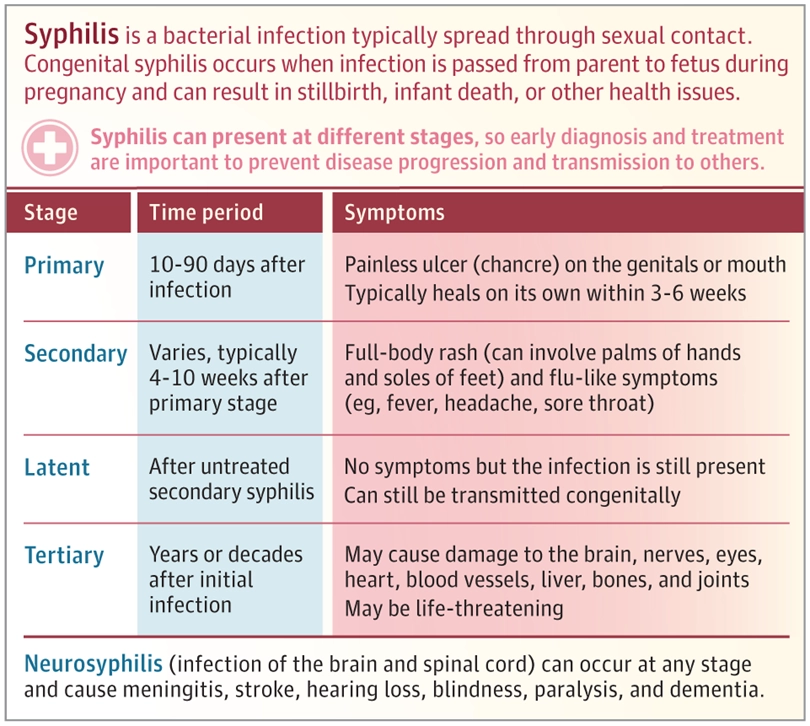En atención a la creciente preocupación sobre la confianza en...
Leer más
What Is Syphilis?

Syphilis is an infection caused by the bacterium Treponema pallidum.
Syphilis is a sexually transmitted infection that is acquired through genital, oral, or anal sex. Syphilis can also be passed to a fetus during pregnancy, causing congenital syphilis. Early diagnosis and treatment of syphilis is important to prevent progression of the disease and avoid transmission to others. Syphilis infections can be decreased by use of condoms during sex.
In the US, the rate of syphilis infection has increased over the past 2 decades, and 41 655 new cases of syphilis were reported in 2020. Men who have sex with men account for about half of all new cases of syphilis in the US, but recently there has been an increase in syphilis infections in women and more cases of congenital syphilis.
Signs and Symptoms of Syphilis
Syphilis can present at different stages. Primary syphilis usually appears as a painless ulcer (chancre) on the genitals or mouth but can appear on other parts of the body. Chancres typically heal on their own in 3 to 6 weeks, so they often go unnoticed and untreated.
Without treatment, approximately 25% of patients with primary syphilis develop secondary syphilis, which involves spread of T pallidum through the bloodstream. Symptoms of secondary syphilis typically occur 4 to 10 weeks after primary syphilis infection and include whole-body rash (including palms and soles of the feet) and flu-like symptoms. Without treatment, secondary syphilis is followed by latent syphilis, a period during which patients have no symptoms, although the infection is still present in the body. Tertiary syphilis can occur years or decades after initial infection and may cause enlargement of the aorta (aneurysm), resulting in cardiac valvular dysfunction and heart failure, as well as bone fractures and painful skin ulcers.
Neurosyphilis, which involves infection of the central nervous system, can occur at any stage of syphilis infection and may cause meningitis, stroke, hearing loss, blindness, paralysis, and dementia if untreated. Congenital syphilis can cause stillbirth or infant death. Children with congenital syphilis may develop skin rash; teeth, bone, and facial abnormalities; visual impairment; deafness; and intellectual disability.
How Is Syphilis Diagnosed?
Syphilis is typically diagnosed by testing blood for specific antibodies against T pallidum or by nontreponemal antiphospholipid antibody tests, such as the rapid plasma reagin (RPR) and venereal disease research laboratory (VDRL) test. Some laboratories can perform polymerase chain reaction (PCR) testing to identify T pallidum.
Who Should Be Tested for Syphilis?
Syphilis testing should performed for all patients with symptoms characteristic of syphilis infection. Sexual partners of a person diagnosed with syphilis should be notified and tested for syphilis. Screening for syphilis with a blood test in asymptomatic people should be performed at least once a year for those who are at increased risk of infection, including persons with HIV and men who have sex with men. All pregnant individuals should be screened at their first prenatal visit; those who live in a community with high rates of syphilis should be tested again at 28 weeks of gestation.
Treatment for Syphilis
The treatment of choice for syphilis is penicillin, given as an intramuscular injection or intravenously, and a single dose is curative for early, uncomplicated syphilis. For patients with penicillin allergy, alternative drugs or penicillin desensitization procedures can be used.

Source: https://jamanetwork.com/journals/jama/fullarticle/2804366?guestAccessKey=e3eb8207-94ef-4f68-b818-bd42f62134c6&utm_source=fbpage&utm_medium=social_jama&utm_term=9644283539&utm_campaign=article_alert&linkId=210882783




